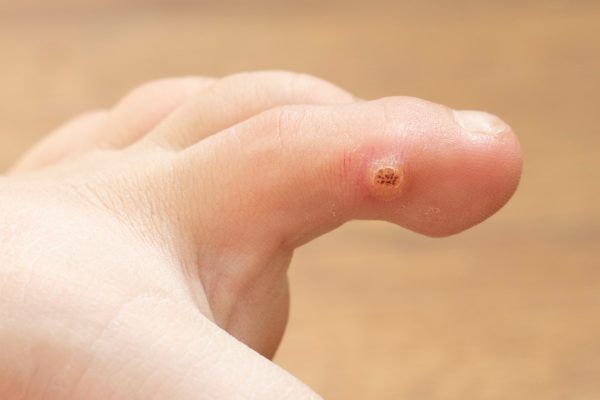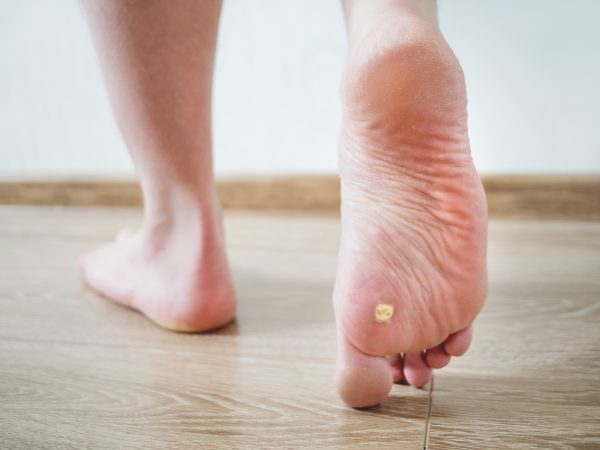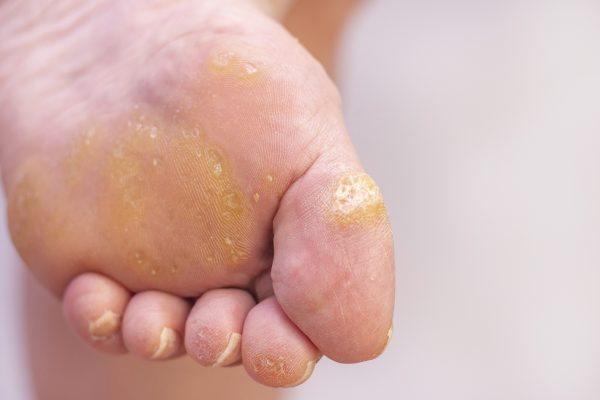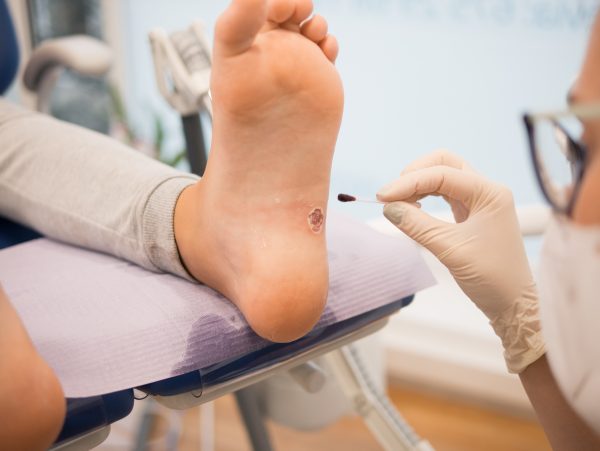When you have your shoes on, do you experience a painful rubbing sensation on bumps that resembles blisters? There’s something strange about these growths too, since they have little black dots on them…
Whether these wart-like masses are in between your toes or on the bottom of your feet, they can be a real burden when standing or walking— and a true nightmare for athletes or active folks.
In this post, we’re here to help you determine if those bumps are foot warts, AKA plantar warts, and to get you the care you need.
What is a Foot (Plantar) Wart?
While warts can appear on your hands or other parts of your body, we’re here to discuss foot-formed warts, referred to as “plantar warts.” (Plantar being in reference to the pain you feel when planting your feet. “Palmar” warts occur on the hands or palms).
Plantar warts are hard bumps that form on the bottom pads or sides of your feet or between or on top of your toes. These growths are often hard, “grainy”— in that they have a rough, bumpy texture— and fleshy.
Oftentimes, but not always, they have tiny black dots, called “pinpoints” or “wart seeds” which are small, clotted blood vessels. Sometimes these black specks do not appear on early stage warts, but rather develops in time as the wart expands and further affects your blood vessels. See picture below for reference.

Plantar Wart Symptoms
If you have a lesion on your foot, lookout for these symptoms of a plantar wart:
- A fleshy growth that’s sometimes raised, usually on the bottom of your foot or inside of the toes
- A grainy texture on the lesion, often with black pinpoints (wart seeds)
- Dry skin or a callus developing over the wart, wherein the wart begins growing inward
- Pain or tenderness when standing or with activity

Plantar Warts & Calluses
It can be hard to spot plantar warts when they are also associated with calluses. The formation of the callus is your body’s natural reaction to prevent the spread of the viral infection, often forming as a result of the wart’s spread.
While calluses are typically yellow, flat, dry patches of skin, warts growing within the space of the callus have a tendency to grow inward instead of out/upward— meaning they flatten instead of raising. This makes it harder to detect the presence of warts.
See the picture below for reference. Notice the white “spots” on the callus, indicating the warts are growing inward.

The Cause of Plantar Warts
If you check the boxes above for the symptoms of foot warts, be sure to understand the cause of plantar warts before assuming that’s your diagnosis— since many other conditions produce the same or similar symptoms of foot warts but are caused by different things (like corns or blisters).
Any wart on the body is the result of a viral infection. Plantar warts, in particular, are caused by the human papillomavirus (HPV).
But how do you pick up the virus? The virus can live on surfaces, particularly in damp, moist environments. Think pools, showers, yoga class mats, etc. Once stepped on, the virus can enter your skin through small cuts or scrapes on your feet, instantly infecting you. While the virus enters you from that initial exposure, it can take weeks for it to run its course through your system and to develop the warts themselves.
Those at High Risk
As we age, most people build immunity to HPV, which is why plantar warts are more common in children and young adults than others. However, those with weaker immune systems, who are on certain corticosteroid or immuno-supressive medication, or have other conditions like AIDs may be at higher risk of worsening the spread of foot warts. This is also the case for those with diabetes or poor sensation in their feet, making it harder to detect the painful feeling of and fight the spread of plantar warts.
Those who walk around barefoot, especially in communal spaces, or who go for pedicures where the salon does not properly disinfect tools or equipment are also a much higher risk of contracting the virus.

Is it Time to See a Doctor?
While most plantar warts won’t seriously affect your health and go away in time without treatment, the warts can be professionally removed for a quicker turnaround. For those with weakened immune systems or pre-existing conditions who have warts that persist or recur, this is sometimes the best treatment method.
Plus, because plantar warts are similar in appearance to bumps on the feet such as corns or blisters, it can be difficult to self-diagnose this foot condition. Warts that last for many months may not be plantar warts at all and require attention from a podiatrist.
Come in to have your warts professionally diagnosed and removed by exploring our Plantar Warts services page or call 239.936.5400, today.
Categorized in: Blog
Comments are closed